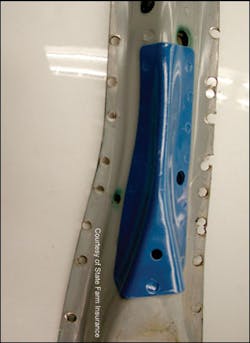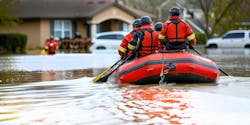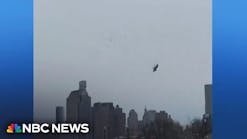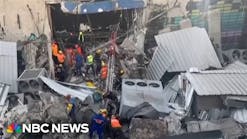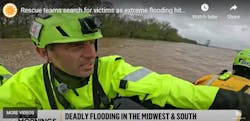Subject: Subaru Ring-Shaped Reinforcement Frame
Topic: Design and construction of Subaru Ring-Shaped Reinforcement Frame
Objective: Develop an action plan for extrication tasks requiring removal of select model Subaru B-pillars
Task: Describe the tools and techniques that could be used by your department to cut through or remove the B-pillar of a Subaru Impreza, WRX, WRX STi, Forester, Legacy, Outback or Baja model vehicle.
As an emergency responder, I've noticed that occupants of late-model Subaru vehicles are surviving some pretty severe side-impact collisions with relatively minor injuries, if any at all. Although the doors may be jammed when we get there, the side of the vehicle most likely held up well.
During an extrication seminar I was conducting in the Fishkill, NY, area in 2004, several members of an area fire department approached me with a question and a challenge. They had encountered a Subaru Forester involved in a crash and were unable to cut through the B-pillar with any of their extrication tools. Their cutter and their reciprocating saw were both unable to sever the pillar. They went back to the junkyard the next day and used a gasoline-powered rotary saw with an abrasive blade to remove the B-pillar. They brought it to the seminar to show me.
When I saw the pillar that day, it was clear that something was very different with the Forester's B-pillar construction. The pillar was eight layers thick! One of the layers of steel was a round steel rod that resembled a concrete rebar. That B-pillar had more layers of steel than I had ever seen before in a vehicle.
In September 2005, the Orangeburg, NY, Fire Department responded to an incident involving a four-door Subaru WRX STi. The Subaru collided with a Dodge minivan at an estimated speed of 75 miles per hour. The broadside impact required the rescue team to remove the roof. The Subaru's A-pillars cut through quickly but the B-pillars again resisted every effort by the department to cut them.
With the cooperation of the corporate communications department at Subaru of America Inc. headquarters, I was able to study this vehicle construction feature in more depth. I learned that the reinforced B-pillars are just one component of what Subaru calls its "Ring-Shaped Reinforcement Frame body structure."
Rings of Safety
This innovative Ring-Shaped Reinforcement Frame body structure provides certain Subaru vehicles manufactured since model year 2002 with some unique crash protection. It also presents us with some unique extrication challenges.
The Ring-Shaped Reinforcement Frame is part of a structural body construction in which body side panels and the pillars around them are connected and reinforced to form three rings. The A-pillars and the front firewall structure make up one ring. Both B-pillars along with two structural frame members in the floorboard and two specially shaped structural members running across the roof area make up the center ring. The third ring is formed by the C-pillars and a strengthened lower rocker sill area. This construction design resists collision failure quite well and maintains passenger compartment integrity by dispersing the impact of the crash away from the occupants.
Subaru B-pillars
The Subaru Impreza, WRX, WRX STi, Forester, Legacy, Outback and Baja models all feature heavily reinforced B-pillars. The pillars are perfectly normal looking. The design of this structural member and the choice of steel used, however, make it a very substantial component of the vehicle "crashworthiness" system and a true rescue challenge at a crash scene.
The metal of the entire B-pillar is high-strength, high-tension steel. Boron is an example of this type of exotic metal. In addition, the individual roof pillars are called tailored-blank welded B-pillars and are cut with a laser then welded along their edges to form the eight-layer pillar.
Not only is the metal in this area thick, it also has a round steel bar section in its core. Ironically, in both extrication case studies mentioned earlier, rescuers unknowingly attempted to cut the B-pillar at the point where it is intentionally the thickest and the strongest. The round rebar steel rod is only a little over 12 inches long and begins at the dashboard level and ends at almost the height of the roof rail. In this same middle portion of B-pillar there is also an extra layer of exotic metal steel added to the inside and the outside surfaces to further reinforce and strengthen the pillar.
Alternate Techniques
Many of our current hydraulic cutting/shearing tools have problems coping with these pillars. Our hacksaws, reciprocating saws and air chisels are useless against these exotic metals. Rotary saws with abrasive blades will overpower this metal and cut the pillar but their use isn't practical at extrication scenes.
During roof removal evolutions, the B-pillar must typically be cut through. As an alternative to cutting a Subaru B-pillar, rescuers will be able to make two cuts into the roof rail at the top of the B-pillar forming an inverted "V" cut. This will separate the roof from the top of the pillar allowing the roof to be removed. Another option will be to "flip," "flap" or "flop" the front portion of the roof, making a hinge cut in the roof rail in front of the B-pillar. Remember, the A-pillars and roof rail are of a conventional design and will not offer the resistance that the Subaru B-pillars will.
Besides rescuers preparing options for cutting exotic high-strength, high-tension structural metals, the challenge is out there for our rescue tool manufacturers to create power cutters that can deal with these reinforced pillars. With the federal government pushing for better vehicle side-impact performance and standards to require better roof crush performance developing, we will be seeing more reinforced A-, B-, C- and D-pillars and we will see the increased use of exotic martensite (boron) high-strength, high-tension steels.
Ron Moore, a Firehouse contributing editor, is a battalion chief and the training officer for the McKinney, TX, Fire Department. He also authors a monthly online article in the Firehouse.com "MembersZone" and serves as the Forum Moderator for the extrication section of the Firehouse.com website. Moore can be contacted directly at [email protected].
